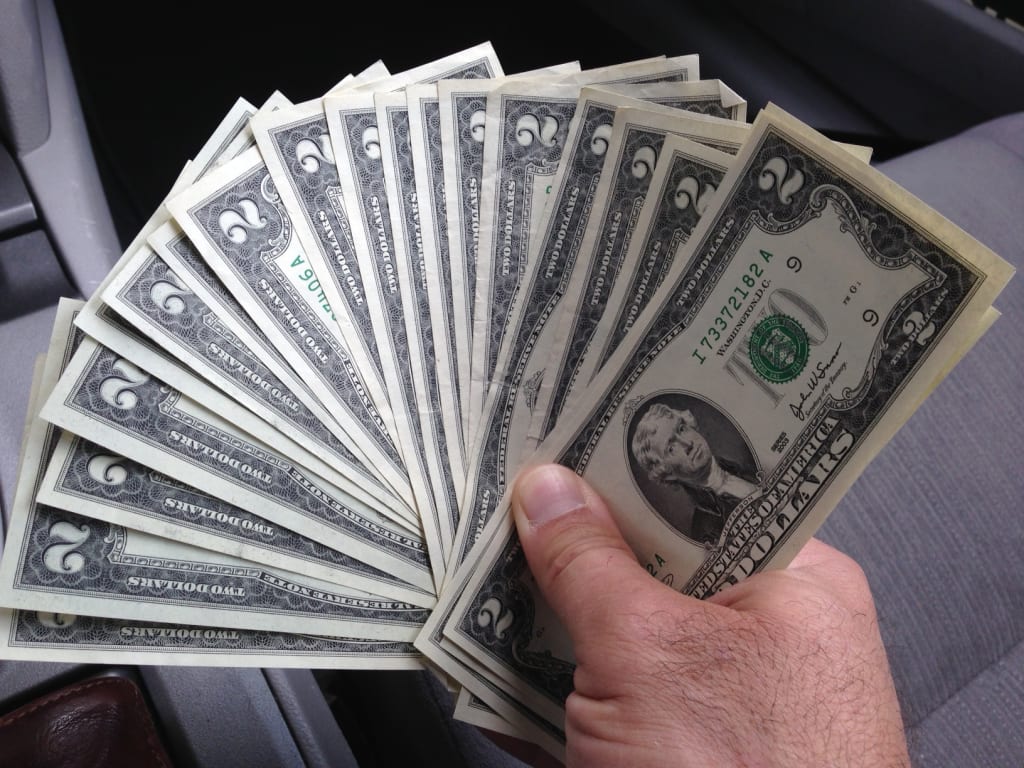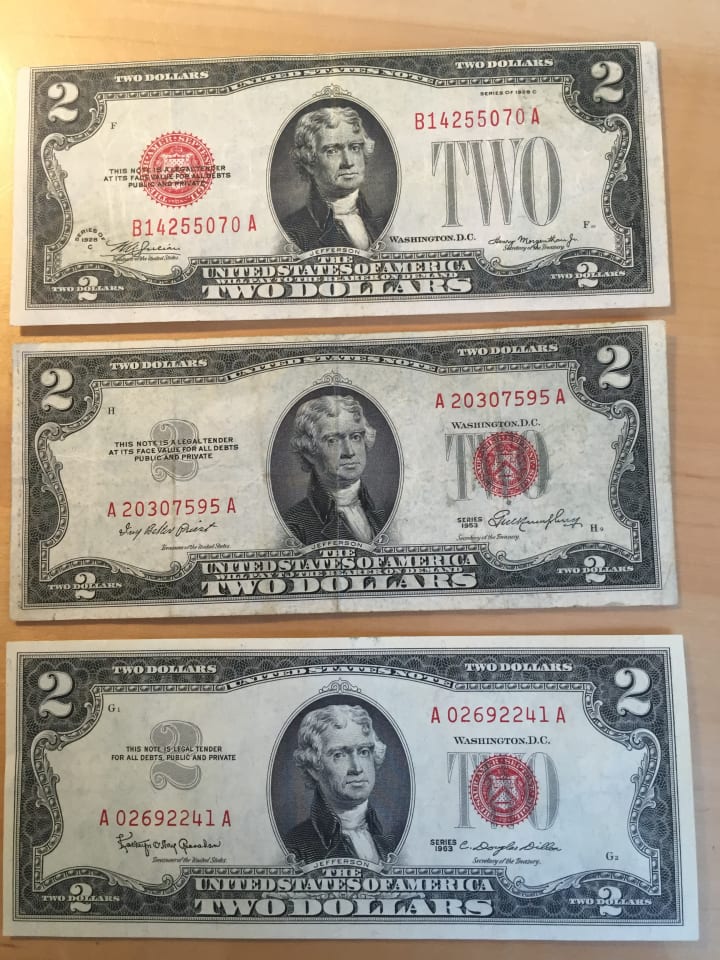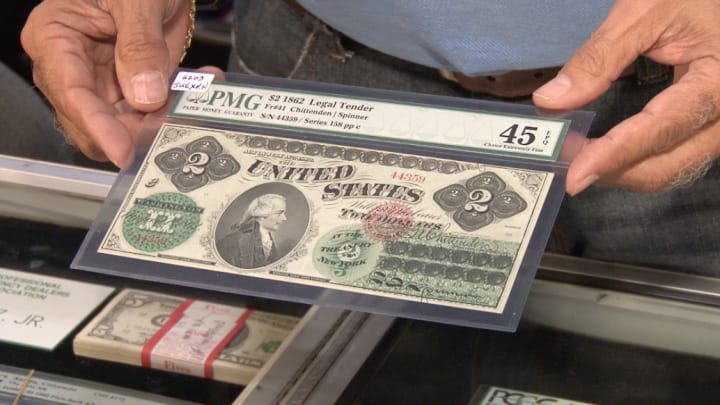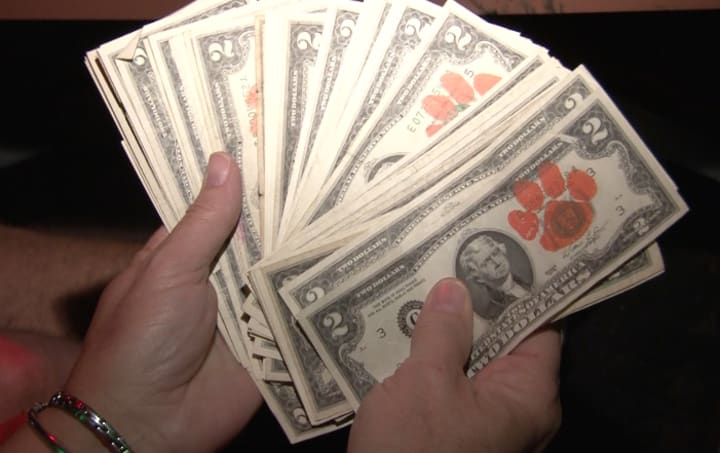$2 bills are real, and they're spectacular
There's plenty you don't know about this quirky currency

They sat in an old checkbook box in my desk drawer, sandwiched between registers from an account closed pre-Y2K and an article I saved about baseball betting called "Make 1991 Your Best Summer".
Once every six months or so, I’d pull them out to fawn over them, savor the way they felt, and wonder what I could do with them besides keep them captive next to a rubber address stamper. I mean, I couldn’t actually spend them, could I?
I’m talking, of course, about $2 bills.
Maybe you’ve had a similar experience. You came across the quirky currency somewhere in your life and thought it was a collectible. You stashed it in a particular place that you revisit on occasion because the bills smell like the U.S. Mint and have a texture that your fives and tens have never been able to replicate. You fantasize about selling them someday and retiring, yet you also don’t know if you could ever do without them. They are magical.
I would never spend mine, but the pit in my stomach over wanting to put them to use became overwhelming. I had recently finished my second documentary short film and was looking for a new project. As I sifted through the bills – just to hear that melodic crisp-paper-on-crisp-paper sound – I knew that a documentary about them was what I had to do.
Like many people, I assumed that twos were rare and out of print. My collection of eleven bills had to be worth thousands, I thought. I’d share a little history, and the rest of the film would be some hidden camera hijinks of my trying to spend them at a 7-Eleven.
Boy, was I wrong.
My thorough understanding of this delightful denomination began at a numismatics trade show in Orlando, Florida. Armed with a cameraman colleague and a copious amount of curiosity, I chatted with vendors who taught me so much about the bill, I could have stopped and edited an entire film right there.

My eleven two dollar bills were each worth precisely two dollars, they told me, but if I had one with a red treasury seal and serial numbers, it might have more value. These bills were issued in 1928, 1953, and 1963, but in diminishing amounts. The bill was used so infrequently, and there was so little demand that it was discontinued in 1966.

Ten years later, to celebrate the bicentennial (and save some money on printing costs, since half as many bills could yield the same value as ones), the two was redesigned and reissued. The Federal Reserve pushed banks to give them out to increase circulation. But the depiction of John Trumbull’s painting Declaration of Independence on the obverse was so gorgeous, consumers believed the bill to be a collectible. They tucked them away for safekeeping – in a sock pile, safety deposit box, or yes, an old checkbook box in a desk drawer.
It also came as a shock to me that $2 bills existed before the 1928 red seals. The first federally-issued two-dollar bill arrived in 1862 and featured Alexander Hamilton, the nation’s first Treasury Secretary. There were multiple iterations of the two through 1918, each exquisitely ornate and some featuring little-known generals as well as some guy named George Washington.


Thomas Jefferson made his first appearance on a $2 bill in 1869, on what was known as a Rainbow note. It was nicknamed this because of its color pattern. Jefferson became a fixture on the bill from 1874 through 1918. At that point, the larger-sized bills were discontinued in favor of a smaller unit, the 1928 issue described above.

Attending this convention had already given me more knowledge (and material) than I ever thought I’d find, but the project was only going to get bigger.
On a shot-in-the-dark phone call to see if I could secure an interview with someone at the United States Treasury, I was told they were printing a new batch of $2 bills in one month, and I was invited to film the process!
Now, my film was legitimate. I spent a memorable day at the Bureau of Engraving and Printing in Fort Worth, Texas, just one day before my birthday. In an interview with the Director of Manufacturing, I learned that twos were printed in 1976 but then again nine more times. The process was fascinating; rather than describe it in text, here’s the film clip where it was detailed:
I now had footage that literally no one else did. I launched a crowdfunding campaign to raise production money, and the response opened my eyes to just how beloved the $2 bill was. People wrote me to share stories of the sacred two their grandparents left them or the wonderful ways in which a $2 bill brings happiness to others when spent. An article on $2 bills in the New York Times mentioned my film, and then I heard from people with all kinds of fascinating stories and connections with the two.
Did you know that $2 bills have been in outer space? That’s what Richard Jurek shared in an interview where he showed off his collection of space-flown $2 bills. Astronauts like the late Gene Cernan took the bills with them in flight, citing them as good luck charms.

How about the fact that many businesses use $2 bills to help brand their establishment or demonstrate their impact on the local economy. I heard that story countless times, most notably from Clemson University's fans, who bring paw-stamped deuces to their college football bowl games to show the host city their spending power.

Many people believe the $2 bill to be good luck, but superstition expert Joe Nickell opened my eyes about the many curses the two supposedly held. For a long time, the bill was associated with bad luck. It had a connection to gambling (two dollars for a bet at the race track), it was the bill paid as a bribe when politicians sought your vote, and it was even the cost of services when you spent an evening with a female companion.
The Illuminati even got themselves into the mix. If you fold the back of a two-dollar bill a certain way, you can see an owl's outline – owls are the symbol of the Illuminati. You can see it in this clip, which also shares more Illuminati hypotheses.
In the two years and two weeks (fitting, eh?) it took to make the film, I became an expert on the topic. I will never spend the eleven $2 bills in my desk drawer, but I made it a habit to go to the bank and get new ones consistently to spread them around and disavow people of their misconceptions. The list of did-you-knows I can throw at someone is almost endless. Get me started about $2 bills at a party (pre-COVID), and you might not be able to turn me off. But I’ll say this: you’ll definitely learn something.
In preparation to write this piece, I opened that checkbook box again and admired each of the bills that inspired my project. Some are bicentennials, but there are a few 1995s and one 2003. They are folded in half but mostly still crisp. I may have handled thousands of two dollar bills since, but these possess a power unlike any other; they bring me back to my youth, to a time when the excitement of discovery gave life more meaning. I don’t have many memories of where I received any of the bills, but I recall a joy and fascination that I haven’t found in too many other material goods.
It’s become a mission of mine to make more people aware of the two-dollar bill. When a recipient tells me how scarce they are, I like to debunk the myth by citing how there are over 1.3 billion two-dollar bills in circulation (more than half the number of tens). I’ll let doubters know they can go to most banks to get a fresh stack of $2 bills if they want one, and when someone shares why they’re hoarding theirs, I’ll offer my two cents: they aren’t worth more than face value unless they have a fancy serial number or printed error.

The facts that juice me more, however, are the ones about personal connection. When you use a two-dollar bill, it elevates the transaction to something memorable. Become the person that pays with them or hands them out as tips, and you’ll always be remembered. You might make some new friends, too. I interviewed over 70 people for my documentary; I’m still in touch with most of them because of the inherent connection formed over our interest in this unique, rectangular piece of paper (made from cotton and linen).
Use $2 bills at your own discretion. My hope is that when you see one in the future – whether in a transaction or the one you pulled from a shoebox to admire - you’ll be able to appreciate it all the more.
About the Creator
John Bennardo
Author of the Amazon bestselling fiction novel "Just A Typo", John enjoys creating new content and entertaining / informing an audience.






Comments
There are no comments for this story
Be the first to respond and start the conversation.